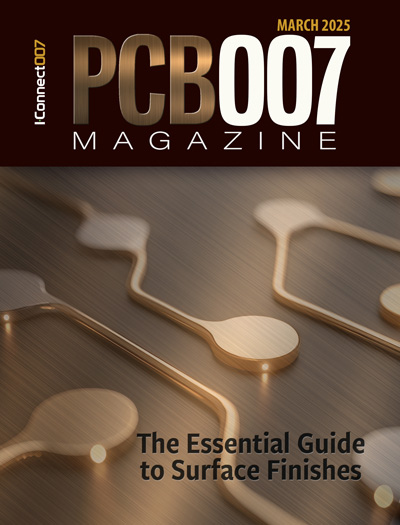-

- News
- Books
Featured Books
- pcb007 Magazine
Latest Issues
Current Issue
In Pursuit of Perfection: Defect Reduction
For bare PCB board fabrication, defect reduction is a critical aspect of a company's bottom line profitability. In this issue, we examine how imaging, etching, and plating processes can provide information and insight into reducing defects and increasing yields.

Voices of the Industry
We take the pulse of the PCB industry by sharing insights from leading fabricators and suppliers in this month's issue. We've gathered their thoughts on the new U.S. administration, spending, the war in Ukraine, and their most pressing needs. It’s an eye-opening and enlightening look behind the curtain.

The Essential Guide to Surface Finishes
We go back to basics this month with a recount of a little history, and look forward to addressing the many challenges that high density, high frequency, adhesion, SI, and corrosion concerns for harsh environments bring to the fore. We compare and contrast surface finishes by type and application, take a hard look at the many iterations of gold plating, and address palladium as a surface finish.
- Articles
- Columns
Search Console
- Links
- Media kit
||| MENU - pcb007 Magazine
Physics, Electrical Engineering, and PCB Design
December 20, 2022 | Tamara Jovanovic, Happiest BabyEstimated reading time: 2 minutes
When I was a sophomore in college, I had an amazing professor for Physics II: Electricity and Magnetism. He made a series of complex topics fun to learn, and his personality and way of teaching were almost tailor-made for the way I like to learn. He explained new concepts through practical examples, and always kept students engaged throughout the class, making sure everyone understood the lectures. Physics II was an engineering prerequisite, and I didn’t mind taking the class since I really enjoyed the material. However, I did find myself wondering a few times, “Will I ever use any physics in real life?”
It turns out that the answer to the question was yes. Through the rest of my undergrad and my master’s program, I have used physics more than just occasionally. To put it plainly, physics is essentially the study of how everything works, and it is everywhere around us. Without realizing it, we use physics while doing simple tasks around the house. The laws of physics describe everything around us, from opening a jar, using our phones, and ironing clothes, all the way to understanding how the human body works, driving a car, natural disasters, and electronics manufacturing.
Electrical engineers use the laws of physics and mathematics to convert electrical energy and power into a circuit, device, or system. Whether it’s semiconductors, circuit design, power distribution, grounding, or shielding, physics is woven through electrical design, and it helps solve complex problems even when we don’t realize it.
Any circuit board design is a process. In my job, the very first step in PCB design is board planning with mechanical engineers. There is usually a specific industrial design that is established as baseline, and we have to work around that when incorporating mechanics and electronics. We discuss critical components and parts, their size and potential location, and we make decisions on where they could be placed, as well as how specific features of the product can be implemented and executed. We also have to ensure that board shape and size can house all the components and circuits that need to be implemented. In the meantime, I start working on board schematics and design validation.
Physical strain on the PCB is another aspect of my job that involves physics. Engineers must select the optimal location for mounting and locator holes on the board. Mechanical engineers perform simulations to make sure that they aren’t putting unnecessary strain on the board and ensure the board doesn’t get damaged during assembly into the product. Once mounting hole locations are identified and the schematic is completed, an electrical/layout engineer can start working on layout.
To read this entire article, which appeared in the November 2022 issue of Design007 Magazine, click here.
Suggested Items
Polar Brings New Book 'The PCB Designers Guide to... More Secrets of High Speed PCBs' to EIPC Edinburgh
05/27/2025 | Polar InstrumentsPolar's latest book, The PCB Designer's Guide to... More Secrets of High Speed PCBs, will see its European Launch at the EIPC conference in Edinburgh, June 3-4, 2025. More Secrets unveils more of the knowledge that is often missed from theoretical text books to help both new and experienced designers realize the PCBs they “thought” they had designed.
FastlinkPCB Accelerates Global Expansion, Builds Efficient PCB Industry Chain
05/26/2025 | FastlinkPCBFastlinkPCB, a PCB manufacturing and assembly solutions provider, announced that it has completed the layout of subsidiaries in the US, Germany, Switzerland, and Malaysia over the past year, forming a localized service network covering North America, Europe, and Southeast Asia.
Defining the Ideal PCB Design Data Output
05/27/2025 | Stephen V. Chavez, Siemens EDAAt the heart of delivering successful, manufacturable printed circuit boards lies a vital question: What should your design data output package include to best support manufacturing? The answer: It depends. There are many factors to consider regarding the specific category you’re designing for—such as mil/aero, space, medical, and commercial. Other factors that need to be considered are requirements and engineering intent.
Indium to Feature Materials Solutions for Semiconductor Packaging and Assembly at ECTC
05/22/2025 | Indium CorporationIndium Corporation®, an industry leader in innovative materials solutions for semiconductor packaging and assembly, will feature its lineup of high-reliability products at the Electronics Component and Technology Conference (ECTC), taking place May 27-30 in Dallas, Texas.
HBM4 Raises the Bar on Manufacturing Complexity, Premium Expected to Exceed 30%
05/22/2025 | TrendForceTrendForce's latest findings reveal that demand for AI servers continues to accelerate the development of HBM technologies, with the three major suppliers actively advancing their HBM4 product roadmaps.


